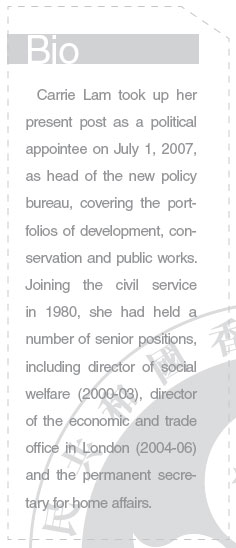New CBD in the making
Updated: 2011-12-23 08:40
By Joseph Li(HK Edition)
|
|||||||


Secretary for Development Carrie Lam extols the virtues of exciting new central business district coming to the Kai Tak Development area, and forming the core of the mammoth energizing Kowloon East project, Joseph Li writes.
The Kai Tak Development (KTD) will be a new, vibrant, mixed node of residential and commercial facilities. With an area of 320 hectares, it includes public housing estates, offices, exhibition and conference facilities, hotel and service apartments, retail and entertainment outlets, sports, leisure and tourist facilities on the site of the old airport. The KTD also will be the prime mover for the facelift of the neighboring industrial districts of Kowloon Bay and Kwun Tong, whose combined area totals 168 hectares.
Speaking to China Daily in an exclusive interview, Secretary for Development Carrie Lam said the KTD presents the opportunity to develop a new central business district (CBD) and transform old industrial districts.
The KTD will have a commercial area of 2 million square metres - equally divided between offices and tourist facilities, including the cruise terminal and the first berth, hotels, plus catering and shopping facilities.
"The KTD new development zone is an invaluable opportunity prompted by demand for more office space," she said with great enthusiasm. "It is a strategic, visionary plan with an integrated approach to develop a new core CBD."
Lam said she took inspiration from her overseas trips. "I noticed that the original CBDs of many big cities are saturated, prompting the need for development of new major business districts. They include Canary Wharf in London, Marina Bay in Singapore and La Defense in Paris that I visited in the past summer," she said.
The KTD will develop in three phases.
"I have to make it clear that the site is not baked in the Sun, as works are in fact ongoing," she said lightly. Phase I, which includes the public housing estates accommodating about 86,000 people, the cruise terminal and the first berth, is expected to be complete in 2013.
"I anticipate the entire KTD project, including the transformation of Kowloon Bay and Kwun Tong, will be complete in 2021," she said.
Hong Kong, as an international financial and business hub, is experiencing a shortage of office space, she observed. Between 2001 and 2010, overall supply of office space grew by a mere 2 million square meters, falling short of the pace established in the two previous decades.
After the financial crisis that broke out in 2008, the office vacancy rate dropped while rents escalated to up to HK$200 per square foot. As this was underway, the number of multinational corporations operating in Hong Kong was increasing, showing that demand for office space exceeded supply.
To increase office supply, the government continued to seek development opportunities in major commercial areas such as Central, Admiralty, Wanchai and Tsim Sha Tsui.
The government also needs to vacate its facilities in the core business districts to make way for development of private offices, she said. If that is still not enough, it is necessary to develop new business districts.
"Now that we have moved into the new Central Government Offices in Tamar, we have further plans to vacate the government buildings in North Wanchai.
"Except for banks, financial institutions and listed companies who wish to stay in Central as the political and economic center, there is no need to remain there and bear the expensive rents," she said.
(HK Edition 12/23/2011 page4)